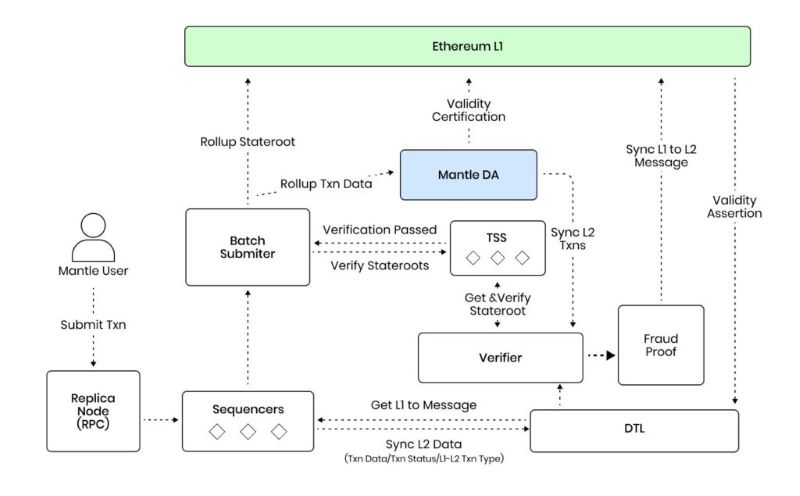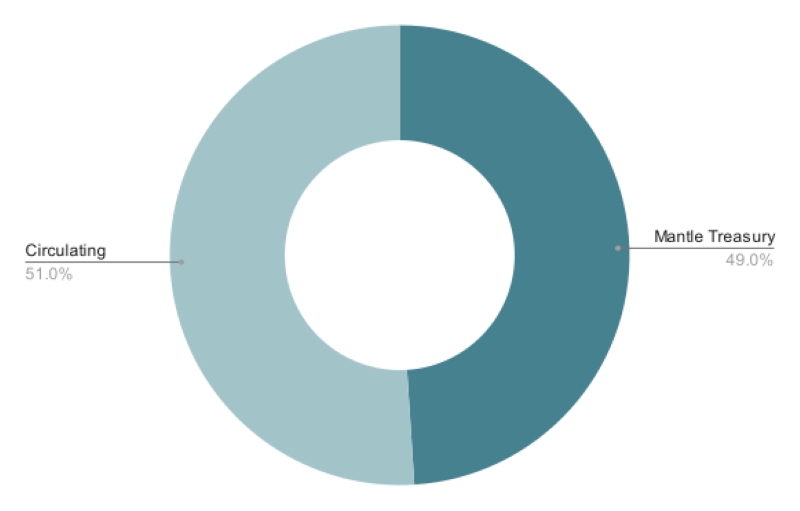Mantle, originally part of BitDAO—one of the largest decentralized autonomous organizations (DAOs) supported by Bybit—has transitioned into its own innovative project. By expanding on BitDAO’s foundation, Mantle has introduced Mantle Network, a Layer 2 scaling solution that supports decentralized applications (dApps) on the Ethereum blockchain, offering improved scalability and efficiency.
Understanding Mantle Network

At its core, Mantle Network is a Layer 2 solution built on Ethereum, leveraging Optimistic Rollup technology. This enables Mantle to retain Ethereum’s security while significantly boosting scalability and flexibility for dApps. The network is constructed with a modular architecture, which simplifies the integration of various components and enhances the user experience by lowering gas fees and increasing transaction throughput.
What sets Mantle apart is its use of EigenDA, an advanced data availability solution from EigenLayer. This integration allows for more affordable data storage while maintaining high security standards.
Addressing Key Challenges with Mantle
Mantle’s design is purpose-built to address several key pain points faced by Layer 2 networks:
- High gas fees: Layer 2 users often face high fees due to the need to post transaction data on Ethereum.
- Limited throughput: Using Ethereum as a data availability layer constrains the scalability of Layer 2 nodes.
- Delayed transaction finality: Traditional Optimistic Rollups can require users to wait up to seven days before their transactions are finalized and assets can be withdrawn.
Mantle’s modular architecture, particularly through the integration of Mantle DA, offers a solution to these challenges. By allowing validators to participate in Mantle’s economic model through staking MNT tokens, the network ensures data reliability and efficiency while utilizing Ethereum’s security features.
Liquid Staking and Other Features
Beyond being just another Layer 2, Mantle introduces Liquid Staking Derivatives. Users and the Mantle treasury can stake ETH on Ethereum via Mantle, receiving mntETH in return. This liquid staking token can be used across the Mantle ecosystem while earning rewards such as MEV and network fees, offering enhanced utility for stakers.
Mantle’s Modular Architecture Explained

Mantle’s innovative architecture uses Smart Contract Rollups combined with modular data availability. The network’s execution layer is compatible with Ethereum’s EVM, enabling seamless transaction processing on Layer 2 while settlement and consensus occur on Ethereum Layer 1.
Key components within the Mantle DA architecture include:
- Operators: Service providers responsible for validating data commitments and staking assets as collateral. Operators handle critical tasks such as block storage and ensuring the availability of transaction data.
- Dispersers: These participants pay for the network’s data availability services, encrypting and distributing transaction data to operators for verification.
- Challengers: These actors play a crucial role in enforcing Mantle’s Proof-of-Custody protocol, ensuring data integrity and penalizing misbehaving operators when necessary.
- Smart Contracts: Deployed on Ethereum, these contracts manage data verification, ensuring only valid data is accepted and recorded.
How Mantle Network Operates
The Mantle Network’s operational flow is designed to maximize efficiency. When users submit signed transactions, the network’s Sequencer processes them into blocks. The Data Transport Layer (DTL) synchronizes these blocks, while Verifiers ensure data integrity by syncing Layer 2 rollup data and verifying its validity.
Once verified, the network’s Threshold Signature Scheme (TSS) Nodes sign off on the transaction batches before they are submitted to Ethereum Layer 1. In cases where the transaction data’s validity is challenged, Rollup Verifiers initiate a fraud-proof mechanism to confirm the legitimacy of the transaction.
Mantle’s Data Availability (DA) Nodes are responsible for storing transaction data and ensuring it is always accessible, providing an additional layer of security by signing off on block data through the BLS signature scheme.
Key Highlights of Mantle Network
- Ethereum Security: All Layer 2 transactions are validated through Ethereum’s security infrastructure.
- Developer-Friendly Environment: Developers can use tools like Truffle, Hardhat, Foundry, and Remix, along with languages like Solidity and Vyper, making Mantle an attractive platform for building dApps.
- Lower Gas Fees: Mantle’s data compression and modular availability reduce gas fees by up to 80%.
- High Throughput and Low Latency: Mantle allows users to customize transaction confirmation requirements, with a minimum latency of 10 milliseconds and a transaction throughput of around 500 transactions per second (TPS).
Mantle’s Future Plans and Growth

In a significant move in May 2024, BitDAO, with support from Bybit, announced a merger with Mantle Network after a community vote on BIP 21. This merger brings together the governance and financial expertise of BitDAO with Mantle’s technical prowess, setting the stage for an expansive digital ecosystem.
Following the merger, Mantle secured substantial funding, including $300 million in stablecoins and over 270,000 ETH, equating to around $485 million. This financial backing will play a critical role in supporting Mantle’s continued growth and development.
MNT Token and Its Utility
Mantle’s native token, MNT, serves as the network’s backbone, playing vital roles in governance, staking, and transaction fees. The total token supply is 6.2 billion, and there is no vesting schedule as MNT’s usage is determined by the DAO’s voting process.
Mantle Network is emerging as a leader in the Layer 2 space, offering a modular, efficient, and secure scaling solution for Ethereum. Its combination of reduced fees, high scalability, and robust security makes it an attractive option for developers and users alike. As the Layer 2 landscape evolves, Mantle is positioning itself to keep pace with innovations like Superchain and Hyperchain, driving the future of blockchain scalability.